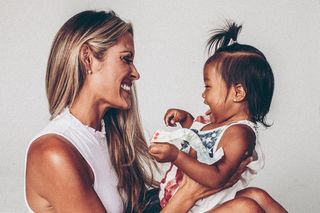Cognition
How to Raise a Bilingual Child: Seven Strategies for Success
Giving your children the gift of bilingualism can enrich their life.
Posted March 15, 2019 Reviewed by Ekua Hagan

Co-authored with Sirada Rochanavibhata, M.A.
In a world that is becoming increasingly globalized and diverse, the ability to speak more than one language may be a desirable trait, especially because bilingualism confers social, economic, and intellectual advantages.
Eighty percent of Americans believe that children should learn a second language fluently before graduating from high school. If you share the sentiment of wanting to raise a bilingual child, here are seven evidence-based suggestions on how to promote successful dual language acquisition in children. While some of these strategies are most applicable to households that are already bilingual, others will be useful even if you don’t speak another language yourself.
1. Increase language quantity.
The quantity of linguistic input children receive in each of their languages predicts vocabulary and grammatical development. The richer the input, the higher the likelihood of successful language acquisition. For example, children who hear a lot of words have a larger vocabulary size. Do not underestimate the power of consistently exposing your child to two languages.
2. Increase language quality.
Quality of linguistic input also influences children’s language outcomes. Having stimulating face-to-face interactions with caregivers is crucial in helping children acquire language. For example, reading books to children supports language development, whereas language exposure via television does not. Low-quality television exposure has actually been associated with lower vocabulary scores in bilingual children. In other words, aim for more face time and choose educational or high-quality children’s television when possible.
3. Enlist the help of family and friends.
Variability in language input is another key predictor of language growth. Having regular interactions with many different speakers of the two languages can help boost bilingual proficiency, as children are exposed to more diversity. In other words, having interactions with extended family members, grandparents, and friends who speak the other language provides further benefit for children’s development.
4. Select a strategy that works best for your family.
There are many different ways to expose your child to two languages, depending on the household. Although no single approach has been identified as the best for raising bilingual children, several have been found to support bilingual language development.
For example, there is the “one person one language” approach, commonly used by two parents who speak different languages (e.g., Parent A speaks one language, Parent B speaks another language). In another common approach, a child is exposed to one language (typically a minority language, sometimes referred to as a heritage language) in the home and a second language (typically the majority language) in school. A different strategy could be to speak to your child in a different language each day of the week.
You can also develop your own strategy—for example, some parents have reported that if a child has watched Frozen a million times and knows every line by heart, having her watch it in Spanish next time may result in her picking up Spanish vocabulary along the way.
5. Consider bilingual education.
During early development, there may be an option of providing bilingual childcare by using babysitters or caregivers who speak another language.
Once your child is of school age, consider schools with two-way immersion programs, which include students of two different native languages in the same classroom and teach content classes in those two languages. In addition to providing children with consistent exposure to two languages across subject areas, which increases the likelihood of the students achieving proficiency in both languages, our research shows that two-way immersion programs also promote students’ academic achievements.
If two-way immersion programs are not available in your school district, there may be other alternatives. After-school or weekend language lessons also provide a formal instructional setting that can promote second language acquisition. Places of worship can also be useful resources if you are trying to raise your child to speak a language that is associated with your faith.
6. Let your child lead the way.
Pay attention to cues from your child and follow their interests. Language development is most successful when children interact with attentive and sensitive adults. A child is more likely to learn new words when an adult focuses on objects that the child is interested in as opposed to what the adult is interested in. Your child will have a higher chance of success in acquiring two languages if they are engaged. To encourage learning, try to find activities involving two languages that interest your child.
7. Continue educating yourself about bilingual language development.
Learn more about bilingualism yourself. There are numerous misconceptions surrounding raising a bilingual child. For example, there are beliefs that bilingualism leads to language disorders and learning disabilities or that bilingual children are confused by hearing more than one language. However, these myths have been debunked. Bilingual children actually achieve important language milestones at the same rate as monolingual children. Good starting points on this topic include resources shared by the Bilingualism Matters Center and books such as A Parents’ and Teachers’ Guide to Bilingualism and The Bilingual Family: A Handbook for Parents.
Final thoughts
Although there are no universal rules to follow when it comes to raising a bilingual child, the most important thing to do as a parent is to provide nurturing support. The approach that you end up taking will depend on the nature of your household, the area you live in, and the resources that are available to you. At the end of the day, focus on raising a happy child. The ability to speak two languages and the cognitive, neurological, and social benefits that come with it are an added bonus.
Viorica Marian is a professor at Northwestern University and the author of the 2023 popular science book THE POWER OF LANGUAGE.
References
Adesope, O. O., Lavin, T., Thompson, T., & Ungerleider, C. (2010). A Systematic Review and Meta-Analysis of the Cognitive Correlates of Bilingualism. Review of Educational Research, 80(2), 207-245. doi:10.3102/0034654310368803
Christofides, L. N., & Swidinsky, R. (2010). The economic returns to the knowledge and use of a second official language: English in Quebec and French in the Rest-of-Canada. Canadian Public Policy, 36(2), 137-158. doi:10.3138/cpp.36.2.137
Dunham, P. J., Dunham, F., & Curwin, A. (1993). Joint-attentional states and lexical acquisition at 18 months. Developmental Psychology, 29(5), 827-831. doi:10.1037/0012-1649.29.5.827
Fan, S. P., Liberman, Z., Keysar, B., & Kinzler, K. D. (2015). The exposure advantage: Early exposure to a multilingual environment promotes effective communication. Psychological Science, 26(7), 1090-1097. doi:10.1177/0956797615574699
Gollan, T. H., Starr, J., & Ferreira, V. S. (2015). More than use it or lose it: The number-of-speakers effect on heritage language proficiency. Psychonomic Bulletin & Review, 22(1), 147-155. doi:10.3758/s13423-014-0649-7
Hoff, E., & Core, C. (2015). What clinicians need to know about bilingual development. Seminars in Speech and Language, 36(2), 89–99. doi:10.1055/s-0035-1549104
Hoff, E., Core, C., Place, S., Rumiche, R., Señor, M., & Parra, M. (2012). Dual language exposure and early bilingual development. Journal of Child Language, 39(1), 1-27. doi:10.1017/S0305000910000759
Hudon, T. M., Fennell, C. T., & Hoftyzer, M. (2013). Quality not quantity of television viewing is associated with bilingual toddlers’ vocabulary scores. Infant Behavior and Development, 36(2), 245-254. doi:10.1016/j.infbeh.2013.01.010
Hurtado, N., Marchman, V. A., & Fernald, A. (2008). Does input influence uptake? Links between maternal talk, processing speed and vocabulary size in Spanish‐learning children. Developmental Science, 11(6), F31-F39. doi:10.1111/j.1467-7687.2008.00768.x
Huttenlocher, J., Waterfall, H., Vasilyeva, M., Vevea, J., & Hedges, L. V. (2010). Sources of variability in children’s language growth. Cognitive Psychology, 61(4), 343-365. doi:10.1016/j.cogpsych.2010.08.002
Marian, V., Shook, A., & Schroeder, S. R. (2013). Bilingual two-way immersion programs benefit academic achievement. Bilingual Research Journal, 36(2), 167-186. doi:10.1080/15235882.2013.818075
National Institute of Child Health and Human Development Early Child Care Research Network. (2006). Child-care effect sizes for the NICHD Study of Early Child Care and Youth Development. American Psychologist, 61(2), 99–116. doi:10.1037/0003-066X.61.2.99
Patterson, J. L. (2002). Relationships of expressive vocabulary to frequency of reading and television experience among bilingual toddlers. Applied Psycholinguistics, 23(4), 493-508. doi:10.1017/S0142716402004010
Pearson, B. Z., Fernandez, S. C., Lewedeg, V., & Oller, D. K. (1997). The relation of input factors to lexical learning by bilingual infants. Applied Psycholinguistics, 18(1), 41-58. doi:10.1017/S0142716400009863
Petitto, L. A., Katerelos, M., Levy, B. G., Gauna, K., Tetrealt, K. & Ferraroi, V. (2001). Bilingual signed and spoken language acquisition from birth: Implications for the mechanisms underlying early bilingual language acquisition. Journal of Child Language, 28(2), 453-496. doi:10.1017/S0305000901004718
Place, S., & Hoff, E. (2011). Properties of dual language exposure that influence 2‐year‐olds’ bilingual proficiency. Child Development, 82(6), 1834-1849. doi:10.1111/j.1467-8624.2011.01660.x
Rivers, W. P., Robinson, J. P., Harwood, P. G., & Brecht, R. D. (2013). Language votes: Attitudes toward foreign language policies. Foreign Language Annals, 46(3), 329-338. doi:10.1111/flan.12048
Song, L., Tamis-LeMonda, C. S., Yoshikawa, H., Kahana-Kalman, R., & Wu, I. (2012). Language experiences and vocabulary development in Dominican and Mexican infants across the first 2 years. Developmental Psychology, 48(4), 1106-1123. doi:10.1037/a0026401
Tomasello, M., & Farrar, M. J. (1986). Joint attention and early language. Child Development, 57(6), 1454-1463. doi:10.2307/1130423




